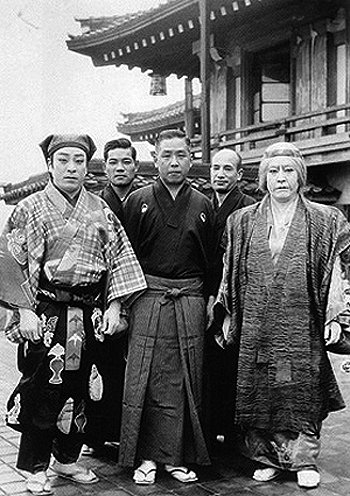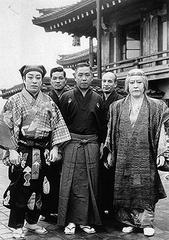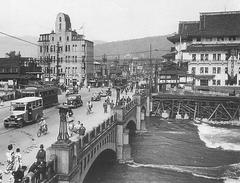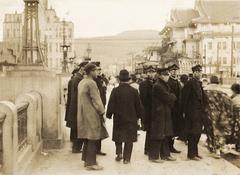
Minami-Za Kyoto Visiting Hours, Tickets, and Historical Sites Guide
Date: 14/06/2025
Introduction
Located in the heart of Kyoto’s Gion district, Minami-Za Theatre stands as one of Japan’s oldest and most revered kabuki theaters. As a living monument to over four centuries of performing arts, Minami-Za offers a captivating blend of history, tradition, and innovative stagecraft. Visitors can immerse themselves in authentic kabuki performances, explore the theater’s architectural grandeur, and enjoy modern amenities designed for an accessible and enriching experience. This comprehensive guide covers Minami-Za’s historical significance, visiting hours, ticketing, accessibility features, travel tips, and nearby attractions, providing all the information you need to make the most of your visit to this iconic Kyoto historical site (traditionalkyoto.com; Kabukiweb).
Table of Contents
- Introduction
- Historical Background
- Visiting Minami-Za: Practical Information
- Frequently Asked Questions (FAQ)
- Visual Highlights
- Conclusion
- Sources and Further Reading
Historical Background
Origins of Minami-Za and the Birth of Kabuki
Kabuki traces its origins to 1603, when shrine maiden Okuni began performing dance dramas by Kyoto’s Kamo River. These innovative, lively performances quickly gained popularity, eventually evolving into kabuki, a dynamic art form blending drama, dance, and music (traditionalkyoto.com). Initially performed by women, kabuki was soon transformed by government edict in 1629, requiring male-only casts and leading to the celebrated tradition of onnagata (male actors specializing in female roles). Minami-Za, founded in 1610, became a leading venue during these formative years (Wikipedia).
Evolution and Architectural Heritage
Minami-Za is the oldest kabuki theater in southern Japan and one of only a handful of officially licensed venues from the early Edo period (Kabukiweb). The theater’s location in the bustling Shijo Kawara entertainment district placed it at the heart of Kyoto’s cultural life. The current building, completed in 1929, reflects the Momoyama architectural style, featuring a sweeping gabled roof, intricate woodwork, and a traditional turret symbolizing official status (japan365days.com). Inside, the theater boasts 1,086 seats, the iconic hanamichi (a runway extending into the audience), a revolving stage (mawari-butai), and trapdoors (seri) for dramatic effects (sanyo-chemical.co.jp).
Major renovations in 1991 and 2018 reinforced the building, improved comfort, upgraded stage technology, and preserved traditional elements, ensuring Minami-Za’s continued relevance and safety as a Registered Tangible Cultural Property (Kabukiweb).
Minami-Za’s Cultural Role
Minami-Za is more than a performance venue; it is a guardian of Kyoto’s performing arts. The theater stages major kabuki events, including the annual December “Kichirei Kaomise Performance,” which brings the nation’s top kabuki actors to Kyoto. Through centuries of social change and modern innovation, Minami-Za has preserved and promoted kabuki, serving as a symbol of community resilience and cultural continuity (Travelpreneur Life).
Visiting Minami-Za: Practical Information
Visiting Hours
- General Hours: Typically 9:00 AM to 6:00 PM; extended during performance days
- Box Office: Opens from 10:00 AM; check official schedules for updates
- Performance Times: Vary by program and season; always verify current hours via the official website
Tickets and Pricing
- Price Range: Approximately 3,000–27,000 yen, depending on seating and performance
- Beginner Events: Kabuki Appreciation Class tickets from 4,000 yen
- Purchase Options:
- Online via Kabukiweb
- At the Minami-Za box office
- Through authorized travel agencies
- Booking Tip: Reserve early, especially during peak seasons and special events
Accessibility
- Wheelchair Access: Ramps, elevators, accessible seating, and restrooms available
- Language Support: English audio guides, printed synopses, and bilingual staff
- Support Services: Notify staff in advance for special accommodation needs
Facilities, Amenities, and Services
- Ticketing and Information Desks: Multilingual service at main entrance
- Audio Guides: Available in English for select performances (japan365days.com)
- Cloakroom/Lockers: Secure storage for personal items
- Restrooms: Modern and accessible facilities on each floor
- Concessions and Souvenirs: Snacks, drinks, and kabuki-themed gifts
- Lounge Areas: Spaces for relaxation during intermissions
Guided Tours and Special Events
- Backstage Tours: Occasional guided tours and interactive experiences (check availability on the official site)
- Annual Highlights: The “Kichirei Kaomise Performance” (December), beginner-friendly performances, and costume experiences
Nearby Attractions
Situated in Gion, Minami-Za is steps from:
- Yasaka Shrine: Kyoto’s celebrated Shinto shrine
- Hanamikoji Street: Famous for geisha culture and traditional tea houses
- Maruyama Park: Popular for cherry blossoms and seasonal festivals
- Kenninji Temple: Kyoto’s oldest Zen temple
- Pontocho Dori: Historic dining and nightlife district
All are easily accessible on foot, making Minami-Za an ideal anchor for a day of cultural exploration.
Travel Tips
- Book tickets in advance, especially during cherry blossom and autumn foliage seasons
- Arrive early to enjoy the theater’s façade and nearby Gion streets
- Bring a translation app or phrasebook; English support is available for most performances
- Dress respectfully and observe theater etiquette (no photography during shows unless allowed)
- Use public transport: Gion-Shijo Station (Keihan Line) is one minute away; Kyoto-Kawaramachi Station (Hankyu Line) is a ten-minute walk
Frequently Asked Questions (FAQ)
Q: What are Minami-Za’s visiting hours?
A: Generally 9:00 AM–6:00 PM, with extended hours on performance days. Always check the official website for schedules.
Q: How can I purchase tickets?
A: Tickets are available online, at the box office, and via authorized travel agencies.
Q: Is Minami-Za wheelchair accessible?
A: Yes, the theater has ramps, elevators, accessible seating, and restrooms.
Q: Are English guides available?
A: English audio guides and printed synopses are provided for select performances.
Q: What attractions are near Minami-Za?
A: Yasaka Shrine, Hanamikoji Street, Maruyama Park, Kenninji Temple, and Pontocho Dori.
Visual Highlights
Alt text: Exterior of Minami-Za Kabuki Theater in Kyoto, featuring traditional Japanese architecture with red lanterns.
Alt text: The hanamichi stage walkway extending through the audience at Minami-Za Theater.
Alt text: The main entrance to Minami-Za Theatre in Kyoto’s historic Gion neighborhood.
Alt text: Map highlighting Minami-Za’s location and nearby cultural attractions in Kyoto.
Conclusion
Minami-Za Kabuki Theater is a living testament to Kyoto’s enduring cultural legacy and Japan’s vibrant performing arts tradition. With its breathtaking Momoyama-style architecture, innovative stage features, and centuries of kabuki artistry, Minami-Za offers a truly immersive experience for visitors. Accessibility, modern amenities, and English-language support ensure that everyone—whether a kabuki aficionado or first-time traveler—can appreciate this national treasure.
To make the most of your visit, consult the official Minami-Za and Kabukiweb websites for the latest on visiting hours, ticket availability, and special events. Enrich your journey by exploring nearby Kyoto historical sites and using the Audiala app for interactive guides and travel tips. Minami-Za is not just a theater—it’s a gateway to the heart of Japanese culture.
Sources and Further Reading
- Minami-Za Kabuki Theater in Kyoto: Visiting Hours, Tickets, and Cultural Significance, 2025, TraditionalKyoto.com (traditionalkyoto.com)
- The Cultural Significance of Minami-za: A Historic Kyoto Kabuki Theater Experience with Visiting Hours and Ticket Info, 2025, Kabukiweb.net and Travelpreneur Life (Kabukiweb), (Travelpreneur Life)
- Minami-Za Theatre Visiting Hours, Tickets, and Guide to Kyoto’s Historic Kabuki Venue, 2025, Japan365days.com (japan365days.com)
- Minami-Za Theatre in Kyoto: Visiting Hours, Tickets, History, and Cultural Experience, 2025, Kabuki-bito.jp Official Site (kabuki-bito.jp)
- Minami-Za Kabuki Theater Architecture and Technical Innovations, 2020, Sanyo Chemical Co., Ltd. (sanyo-chemical.co.jp)














































































